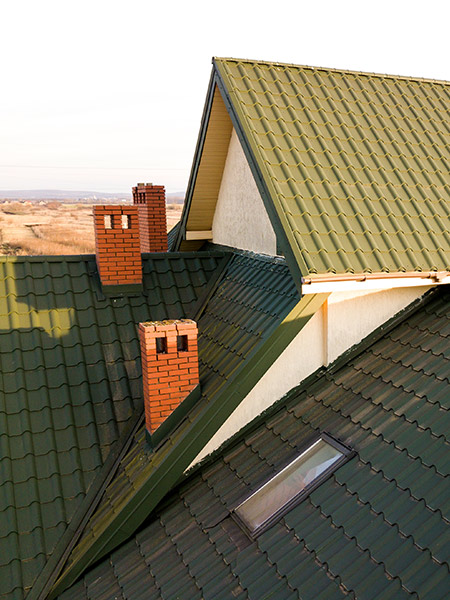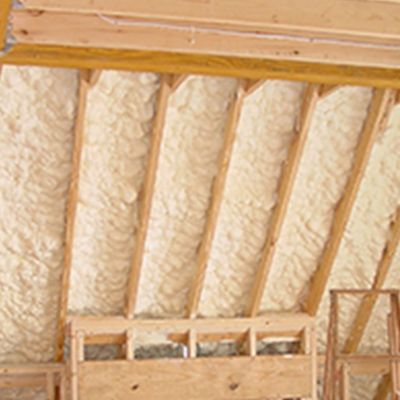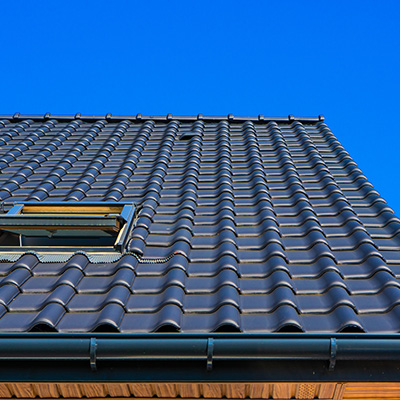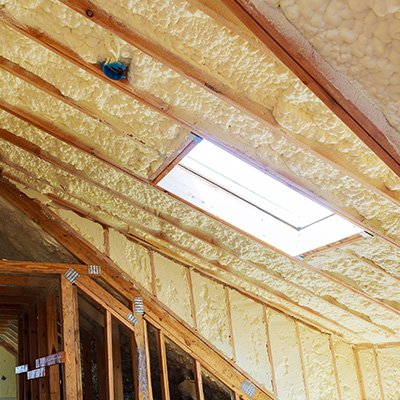Spray foam roof insulation is one of the most efficient ways of heating your home, and can save you money on your monthly energy bills, too.
If you notice that the temperature is uneven in your home, and the rooms are feeling draughty, it’s definitely worth considering installing spray foam roof insulation. Poor insulation can lead to a number of serious problems in a property, and if these issues get worse, you may regret not taking action sooner.

Roofs typically fall into two categories: flat or pitched. You’ll need to take your roof type into account when it comes to choosing your roof insulation.
A pitched roof is one of the most common types of roofs on residential properties. Any roof with an angle of between 10° and 70° is classified as a pitched roof. Though the loft of your home will have angled walls, many people still chose to convert their lofts into additional bedroom or office space.
When insulating a pitched roof, there are many suitable insulators for you to choose from, including our most recommended; spray foam.
A flat roof is a less common type of roof. If you have this type of roof, then you definitely need some form of insulation, as they are more susceptible to harsh weather conditions.
Additionally, flat roofs can pose a danger due to their structure. Water can easily build up on a flat roof, resulting in leaks, mould growth, and, in worst case scenarios, structural damage. However, with a high-quality flat roof insulation, you can help reinforce the building structure, as well as use waterproof materials that will prevent moisture problems.
No matter what insulator you decide to go for, we recommend that you leave the installation to a professional. This will ensure the installation is carried out safely and to premium standards – maximising the effectiveness of your insulation.
Spray foam roof insulation is an excellent alternative to traditional insulation types. It’s extremely versatile, and can be used in a multitude of areas in the home, including the roof, walls, and crawl space of your house.
You can use spray foam to insulate even the hardest to reach places with ease, because it quickly fills every nook and cranny that it’s sprayed into. The material expands right up to the edges when it fills an area, providing a virtually airtight seal.
This air barrier is what sets spray foam roof insulation apart from the rest. In addition to its thermal benefits, the air barrier prevents the mixing of cold and warm air within your living space, greatly reducing the risk of condensation and mould. This, in turn, extends the lifespan of your home and protects your belongings inside.
Uninsulated homes lose up to 25% of heat through the roof, so if you’re looking to fix heat loss issues, insulating the highest part of your house is a strong place to start. Having spray foam roof insulation installed will bring about the following benefits:
With a quality roof insulation, you can reduce the percentage of heat that is lost through the roof, and keep it inside. This means that you’ll use less energy to heat your home, and in turn will see a reduction in your energy bills, too.
While you reduce your energy consumption, you’ll also be reducing your carbon footprint. The amount of energy it takes to heat and cool your home has damaging effects on our environment. But with roof insulation, you can make better use of this energy. As such, spray foam roof insulation is a sustainable solution for your home.
Apart from creating an eco-friendly and energy-efficient home for you to live in, quality spray foam roof insulation will also boost the structural integrity, and durability of your roof. Additionally, a high energy-efficiency rating can earn you a tax credit, and increases your home’s resale value (by an average of £12,500 nationwide) if you decide to put it on the market in the future.

When it comes to choosing the right type of roof insulation, there are several factors you will need to consider.
Firstly, you can expect to see variations in prices when you’re searching for the perfect roof insulant. Prices will vary depending on a number of factors, including the type of insulant you choose, and the company installing it. It’s a good idea to set a budget beforehand, so you know exactly what’s in your price range, and you don’t go over it.
Each type of insulation has its own pros and cons, and it helps to carefully consider each kind before you decide which one is right for you. Certain insulators are better at trapping heat, and may be more preferable, albeit more expensive. The thickness of the insulation is also a factor when it comes to cost; a thicker layer of insulation will be more effective, but will also be more expensive.
The type of insulator that you choose must also suit your home and the conditions in your area. For instance, If you live in an area where temperatures are generally mild all year round, it will be better to choose roof insulators that will keep your home cooler. Whereas, if you live in an area that suffers through harsh winters, then ceiling insulators might be more effective at keeping the house warm.
If you need help weighing up any of these factors, then feel free to contact us, and one of our helpful experts will be more than happy to advise you.
If you’re looking to invest in roof insulation, then get in touch with us at EcoSpray-Foam today. We are Icynene-accredited, quality insulation providers who offer bespoke insulation services across the entire United Kingdom, including London, Manchester, and beyond.
To find out more about spray foam roof insulation costs, ask queries about our products and services, or get your free insulation survey for your residential or commercial property, get in touch with us by filling out our contact form. We look forward to hearing from you.

The type of insulation that you should choose depends on the type of roof that you have. You have two options if you have a pitched roof (warm or cold loft insulation) and three options if you’re after the best insulation for flat roof (warm deck, cold deck, or inverted roof).
The simplest and most affordable type of roof insulation is the classic cold loft option, while the warm loft insulation option is also available as an alternative.
You can always consult a professional to help you decide which type of roof heat protection will work best with the kind of roof and home you have.
The benefits that you can get from having loft insulation include:
Unlike traditional types of insulation that settle and shift over time, the roof insulation foam we use remains in situ and adheres to every surface, providing you with an adequate blanket of long-lasting protection.
Installing loft insulation is a great way to minimise your heating bills while making your home more comfortable. You may have to pay the initial roof foam insulation cost at first, but in the long run, you will benefit from savings that will off-set this.
Insulating your roof is one of the best and easiest of all the energy-saving home improvements that you can make. Mineral wool rolls are affordable, and an entire warm roof insulation in a standard home can be done on a budget of as little as just over £200.
The impact it will have on your energy bill depends on the size of your roof, but it should be a priority task if you don’t currently have any loft insulation at all.


Most lofts are insulated with rolls of foil-backed felt or mineral fibre. They work like blankets and retain the warmer air inside your house.
To stop the heat from rising into your loft, insulation is placed between the joists. This type of insulation, referred to as “cold loft”, is quick and easy enough that you can do it yourself.
However, if you have a loft conversion and you want to keep your loft warm, insulation can be fitted to the inside of your roof. This process, referred to as “warm loft insulation”, is a bit trickier to do and is therefore best left to professionals.
Upgrading your property’s thermal efficiency when renovating it is a good way to enhance your heating system’s performance and will help you save a considerable amount on bills.
Insulation and fabric performance are important elements to consider during any renovation project. It’s estimated that around a third of the heat escapes through a structure’s poorly prepped walls, and the rest through ill-fitting windows, doors, and lofts.
Although it’s tempting to spend more money on aesthetics and decoration when renovating your property, that’s often a false economy. Paying for the best insulation for flat roof structures you can afford will improve the functionality of your home! Call us today for a quote. You can expect to get a very reasonable roof foam insulation cost!.
